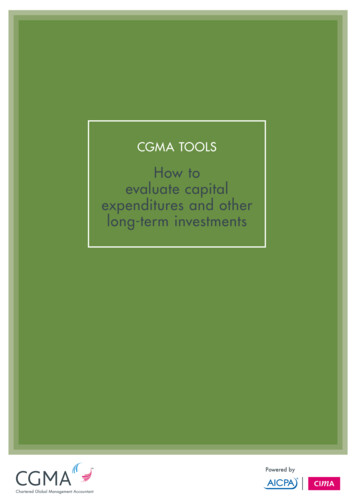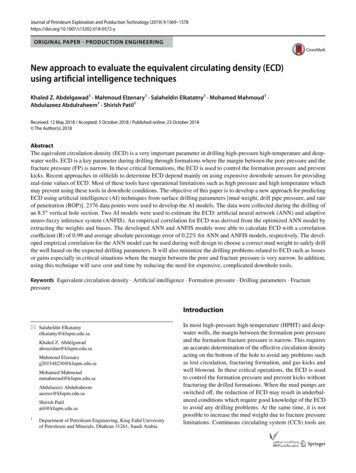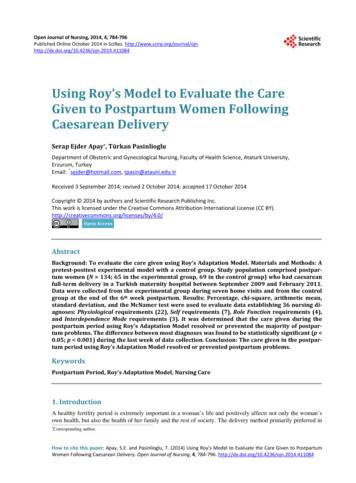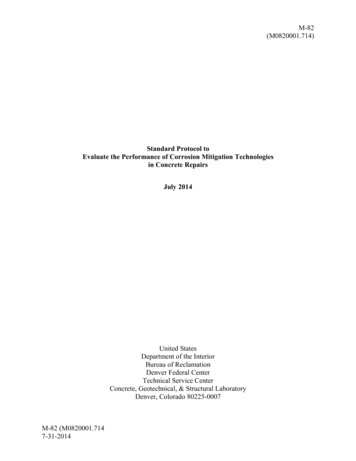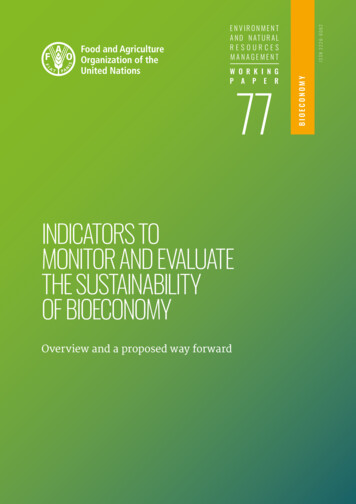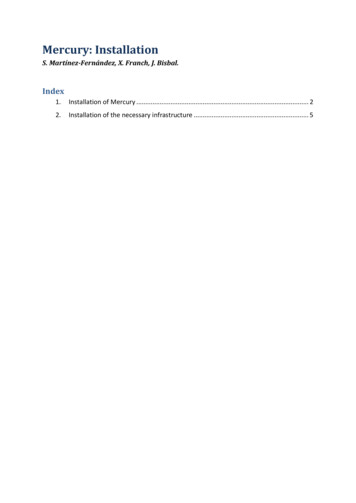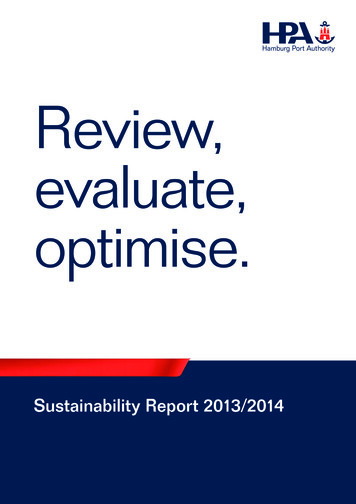
Transcription
Review,evaluate,optimise.Sustainability Report 2013/2014
1Sustainability Report 2013/2014 / FOREWORD01 Jens Meier02 Jens-Erik Wegner0102The next step is complete: You are now holding the second sustainability report of the HamburgPort Authority (HPA) in your hands. The concept of sustainability has increasingly found its wayinto our work and is anchored in our targets to ensure that ecological, economic and social dimensions are taken into account. This approach requires the courage to rethink and compromise –which is the only way the HPA will fulil its corporate and social responsibility to present and futuregenerations as a supra-regional port. Megatrends such as climate change and resource scarcity are closely connected to and have signiicant effects on our economy and society, affectsour stakeholders, and leads us to continuously adapt our company strategy according to thesechanging demands.In this context, the intense dialogue with our stakeholders is extremely important andincreasingly signiicant for us. We are vigorously working on optimising our internal structuresand processes. Our integrated management system will help us to fulil deined tasks in theport eficiently and with legal certainty. Under the heading of “corporate social responsibility”,the HPA is also committed to providing a permanent contribution to the city and the metropolitan area. In this context, we asked ourselves in 2014 what the HPA and its employees stand forbeyond mere task fulilment.Sustainability is a mainstay in our company’s guidelines and a clear signal for the strategicembedding into our daily actions. As an economically led company, tasked with managing theport, we are striving to establish an optimum balance of our economic, ecological and socialgoals. As a result, this report shows a clearly improved ecological orientation compared to our2011/2012 report.Jens MeierJens-Erik WegnerChairman of the Management BoardMember of the Managementresponsible for Sustainable Development
2Sustainability Report 2013/2014 / Sustainable port development as competitive factorTable of Contents01 Foreword03 Sustainable port development as a competitive factor05THE STR ATEGYReview, evaluate, optimise06THE COMPANYClear structures, deined goals09THE PORT10THE CONTENTInternational hub, supra-regional job engineInformation on sustainability reporting11 Investing in a competitive portSustainable development of the infrastructure12THE PATH14THE CHALLENGES16THE APPROACHPreserve and expand the infrastructureInnovative ideas for the eficient infrastructure18 Responsibility for people, environment and societyRelational capital of the HPA19THE STAKEHOLDERS20THE DIALOGUESThe challenges of a city port at the tidal Elbe22THE EMPLOYEESGrowing together – Making things happen24THE PRINCIPLESAct in a proactive and responsible way25 Heading for a green portsmartPORT energy26THE ENERGY TR ANSITION28THE ACTION STEPSEnvironmental management and climate protection31THE COMMITMENTNature conservation32THE IMPULSESIncentives for a sustainable low of trafic and goods33 A sustainable future needs innovative ideas34THE THINK TANKsmartPORT logistics36THE TECHNIQUEGoing for eficient and environmentally friendly road construction37THE MODELOPCIS increases safety on waterways38 General information38 Imprint39 FactsSustainable portdevelopment as acompetitive factor3
45Sustainability Report 2013/2014 / Sustainable port development as a competitive factorThe HPA practices a future-orientedport management from a singlesource since 2005.THE STRATEGYReview, evaluate,optimiseIn light of global megatrends and an ever-changing economicframework, the HPA initiated a change of values with its new2011 strategy. It pursues a development of the port locationHamburg, taking equal account of sustainable aspects of allthree dimensions.The disclosure and evaluation of important aspects therebyfosters the dialogue with stakeholders and affects the qualityof the HPA’s services.The HPA’s report includes all subsidiaries1). The HPA reportsthe results of their sustainability performance every two years.The present report addresses the focus topics and specialactivities of 2013 and 2014. It is aligned with the existing organisational structure of the HPA and covers all units which aresubject to the control of the HPA. As the responsible authority for port and area development topics, the HPA furthermorereports on aspects whose effects are relevant outside of theorganisation.compare the indicators used in the reporting years 2011/2012,which were based on G3.1.Due to methodical changes and content modiications, thepresentation of the 2011/2012 results was waived. The HPAhad an external agency validate the accuracy, completenessand adequacy of this report. The audit review (ISAE3000) hasbeen carried out by the independent auditing irm Deloitte &Touche GmbH2). Compliance has been conirmed with regardto the option “core” in accordance with the reporting standardGRI G4. With the renewed participation in the survey forthe CRI (corporate responsibility index) of the BertelsmannFoundation, the HPA once again faces comparison with otherindustries.Three dimensions of transparent reportingWith the disclosure of its entrepreneurial activities and theeconomic, ecological and social consequences, the HPA isresponding to the requirements of the markets and the public,as well as internal structural demands.In geographical terms, this report covers the area in which theHPA can exert inluence on, rent and manage properties andland, and is responsible for roads, waterways, rails and sites.1)Since this report relects the latest standard of the GlobalReporting Initiative (GRI) G4, it is not possible to directlySee Financial Report for company and ownership structurep. 22 and p. 242) For test result see hures-and-publications/Seiten/default.aspxThree dimensions of transparent g of competitive positionOptimisation of the company’s functionalityIncrease in credibility and acceptance Portfolio expansion with regardto the construction/operation ofcruise terminals Development of a targetachievement system and systemof indicators Disclosure of conlicting goals andinterdependencies Implementation of the smartPORTstrategy for sustainable economicgrowth and optimum customerbeneit with lower environmentalimpact Development of an integratedmanagement system Reduction of environmentaleffects HPA properties as part of the greensupply chain Establishment of healthmanagement Informing and motivatingemployees Integration of stakeholders
6THE COMPANYadjustment during the reporting period. The Federal Administrative Court will irst await the decision on the Water FrameworkDirective by the European Court of Justice regarding the expansion of the Weser.Clear structures,deined goalsSince 2005, the HPA has provided future-oriented port management from a single source and takes care of the Portof Hamburg’s eficiency, security and eficiency. The HPAmeets the port’s growing demands with intelligent and innovative solutions. Responsible for eficient, resource-saving andsustainable planning and execution of the port’s infrastructuremeasures, the HPA is also the point of contact for questionsregarding waterside and landside infrastructure, the securityand eficiency of ship trafic, the dock railway, real estate management and economic conditions in the port, and safeguardsthe port’s interests at a national and international level. Thechallenge for the future is to continue the path set by smartPORT3) and to implement the respective projects.Those who organise well can react to changesThe HPA is regulated by the Ministry of Economic Affairs,Transport and Innovation, Hamburg (BWVI).The company’s corporate bodies4) consist of the supervisoryboard with nine members, and the executive management withtwo members5). The organisational structure of the HPA hasbeen adjusted in 2014 due to changing demands.Three cruise terminal companies6) have been established, forexample, while management committee member Jens-ErikWegner has been appointed as responsible for the sustainable development of the HPA and health management has beenestablished as a department.The release of the Baaken port from the port area was ageographical change that scaled down the area from 42 ha to7,145 ha. Furthermore, due to a change in § 2 of the HPA law,the HPA has become the owner of the parcels named in thearea of the Altenwerder port expansion. The organisationalstructure of the HPA is laid out in such a way that it can reactquickly and lexibly to the demands of the market, politics andits customers.Objectives for a future-oriented portThe HPA develops and operates the Port of Hamburg in acompetitive way for the beneit of both its local and its international customers. The HPA has formulated and decided uponthese tasks in its 2013 company vision.The HPA thinks of economic sustainability as a consciouschoice to protect and increase substance on the basis ofthe port development plan (HEP). Assessments and studiesordered by the HPA are the foundation for the economicaluse of resources, for identifying macroeconomic and politicaltrends and benchmarks and for obtaining direction impulses forthe port’s development plan.In its development planning for long-term (by 2025), medium-term (by 2020) and short-term (by 2015) goals, the HPAneeds to align itself once again to react to changing demands.A procedure for an annual evaluation and deinition wasestablished in 2014. The newly deined goals have been published as part of the works meeting. Target achievementsare communicated transparently, for example in the case ofthe fairway adjustment. Unlike initially hoped, no decision hasbeen made in the legal proceedings regarding the Elbe fairwayOrganisational ChartCC3 Project 3. Cruise TerminalGF Follow sustainable guidelines and principles of resourcepreservation, successfully position the port to competeinternationally. Positioning of the HPA as an attractive employer in thecore area of expertise of Hamburg’s economy. Development of the Port of Hamburg to become one ofthe most intelligent and highest-quality ports in the world. Development of the Port of Hamburg to become one ofthe leading cruise ship destinations in Europe.Mid-term goals (by 2020) Development of the Cruise Gate Hamburg (CGH) asa new business and operational area for all three cruiseship terminals in Hamburg. Climate targets – reduction of CO2 emissions by40 % to 1990 – must be met. Continuous dialogue with relevant stakeholders ofthe port.3) smartPORT see Seiten/Unterbereich.aspx4) The personnel composition of the supervisory board and theexecutive management is listed in the 2014 inancial report p.285) See rtauthority/geschaeftsleitung/Documents/hpa organigramm.pdf6) See 2014 inancial report p. 24 for ownership structureof the new cruise terminal companies7) For corporate guidelines and sustainability policies ) See al AuditIRGBJana MöckelManagement BoardOccupational Safety and HealthMKMarketing and CommunicationPRJörg PollmannStaff CouncilRalf Surm, Doris Heinemann-BrooksLLandside PortInfrastructureBPort RailwayWWaterside nagementCServicesFFinance andReal EstateGL: Jens-Erik WegnerGL: Harald KreftGL: Claudia FleckenGL: Karlheinz PröppingGL: Karlheinz PröppingGL: Dr. Sebastian SaxeGL: Timo KlemmInstrumentsSabine StübenGL:Jens Meier (Chairman),Wolfgang HurtienneHarbour Master‘s DivisionHamburg Port AuthorityCompany GuidelinesManagement Ofice/International ityPrinciplesVisionLeadership GuidelinesValuesSocial IssuesMissionLearning CulturePrevention of CorruptionEconomicsTargets”Error“ CultureData ProtectionEcologySelf-Conception of EmployeesInstrumentsStrategyMarc WittensteinOHSustainability – a pillar of the HPA’s company guidelines7)In its sustainability guidelines, developed in 2014, the HPAcombines all relevant regulations, rules, guidelines and voluntary commitments for working together within the HPA as wellas for contact with customers and the supervisory authority.The sustainability principles as part of the company guidelinesregulate the environmentally friendly and economic actionstaken by the HPA, corporate management and ethics as wellas questions concerning health, transparency and quality. Inthe future, the HPA will take life cycle costs such as operating and dismantling costs into consideration early on in orderto reliably ensure the eficiency of infrastructure projects. Theapproach of considering the usage of environmentally friendlymaterials right from the planning phase, helps to reduce costsand conserve resources. According to precautionary principle15 of the Rio Declaration8), the HPA is committed to considering the effects of its actions and its projects right from theplanning stage. Existing risk and opportunities management istied to the responsible head of a business unit. Their speciicexpertise and leadership skills secure effective risk preventionas part of all day-to-day actions.Long-term goals (by 2025)Hannes SchrankLutz Michael BirkeAS“One-stop port”: guidelines for efficient corporatemanagementThe HPA’s company guidelines and management principles arethe foundation for eficient corporate management. One important aspect of this standardisation is the integrated management system, which brings together quality and environmentalmanagement, risk and opportunities management, occupationalsafety and health protection. Several management areas andhandbooks are used for target setting and evaluation andcontribute to the continuous improvement of corporate management. With its centralised and consistently monitoredmanagement approach for all substantial aspects and ieldsof action, the HPA has management principles on decisionmaking, regulation and feedback at its disposal.ObjectivesCompany guidelinesIris ScheelS7Sustainability Report 2013/2014 / Sustainable port development as competitive factor
8The Port of Hamburg generatesjobs, income security and growthof the region.Sustainability Report 2013/2014 / Sustainable port development as competitive factor9THE PORTInternational hub,supra-regional job engineThe Port of Hamburg generates high levels of employment andadded value, which makes it one of the most important economic factors in the Hamburg metropolitan area. To presentthe regional and overall economic signiicance of the Port ofHamburg, the HPA has PLANCO Consulting GmbH9) analysethe effects of employment, gross value added, revenue andtax revenue.In 2013, Hamburg’s port-related tax revenues amounted to 825 m, roughly 11 % of Hamburg’s tax revenues. With a totalof 11.7 bn, 13.4 % of the added value generated in Hamburgwas achieved in the Port of Hamburg. Very high contributorsinclude the shipping industry at 20 % and logistics providers at19 %. The focus of the Port of Hamburg’s cargo structure is oncontainer goods. Nevertheless, the HPA realised the potentialof the cruise industry as an employment multiplier early on andis therefore promoting the development of the Port of Hamburgas a cruise ship destination10).In 2013, around 53 % of the port-related jobs throughoutGermany were located outside of Hamburg; in 2002 the shareof other federal states was still at 43 %. These numbers clearlyemphasise the increasing spatial networks of jobs related tothe Port of Hamburg.The port generated 13.4 % of Hamburg’s total gross valueadded. When comparing this to the share of employment of thePort of Hamburg for 2013, which amounted to 10.8 %, it is clearthat the jobs in the Port of Hamburg are particularly productive.Direct and indirect customers, markets suppliedWithin the framework of development, maintenance and operation of the port infrastructure, direct customers include shipping companies as well as tenants and users of port real estate,port shippers (Hafenschiffer) and railway companies. Indirectcustomers include senders and receivers of goods and thusalso the international clients of shipping companies and logistic s providers. These are mostly located in North-east Asia, inthe Baltic Region and in the hinterland in Germany and EasternEurope. For the purpose of economical, future-oriented andglobal port management, the HPA is cooperating with nationaland international seaports such as the ElbePorts, Barcelona,Tianjin, Shenzhen, Shanghai, Kaohsiung, and Yokohama aswell as national associations such as the Hamburg LogisticsInitiative (LIHH) and international ones such as the EuropeanSea Ports Organisation (ESPO) and the International Association of Ports and Harbors (IAPH).9) PLANCO expertise 2013 see dien-und-berichte/Seiten/default.aspx10) Compare long-term goals (2025) p. 7 and the chapter “Investing in acompetitive port” from p. 11 onwards
10Sustainability Report 2013/2014 / Investing in a competitive portTHE CONTENTInformation onsustainabilityreportingThe content of this report has been generated in accordance with the reporting standards of GRI G4 by the coresustainability team of the HPA, which is composed of members of different company units such as strategy, inance, HR,marketing and communication, and risk and opportunity management as well as the responsible member of the management board.In 2011, this team was authorised by the management board tolead the sustainability process on behalf of the company andsubmit important decisions for approval.Determination of report content, taking stakeholdersinto accountIn preparation for this report, all topics reported in 2011/2012were checked for their relevance and complemented with current topics. In addition, the HPA conducted an online surveywith selected stakeholders to identify the prioritisation of important topics. For this purpose, stakeholders were evaluated,classiied and categorised. Relevant selection criteria includedtheir position within the supply chain, their inluence on the HPA,the degree to which they are affected by decisions made by andactivities carried out by the HPA and possible legal obligations.In accordance with the system boundaries that were determined for this report, the following stakeholder groups wereincluded: employees, customers, consumers, capital market,political and administrative authorities, suppliers, associationsand non-governmental organisations (NGO). The core teamevaluated the relevance of topics with the help of various factors such as risk minimisation and utilisation of opportunitiesas well as particularly high inluence, far-reaching responsibilityand inancial importance, and then prioritised them accordingly:the relevance of topics from the stakeholder’s and HPA’sperspective (the latter within the framework of a stakeholderanalysis workshop) was prioritised by means of a scoring system and visualised in a matrix.The core team thematically derived all aspects of themateriality analysis with respect to the GRI and chose thespeciic standard speciications11) which relect the main economic, ecological and social impact of the HPA. The selectiontook the delimitation of the main aspects into considerationand has been approved by the management board.Compared to the 2011/2012 Sustainability Report, the scope ofthis report extends to the areas of water, biodiversity, productsand services, transport, equal treatment and labelling of productsand services. Taking test results into consideration, the content ofthis report with regard to the context of sustainability, relevanceand completeness was validated by Deloitte & Touche.11) See lis
Internal Audit Haes Schrank IR Management Ofice/Internatial Affairs Jana Möckel GB Marketing and Communication Sabe Stüben MK Staff Council Ralfurm, Doris Heemann-Brooks PR CC3 Projec3CruisTerminal Iris Scheel S Strategy LutMichaeBirke AS Occupational Sa
